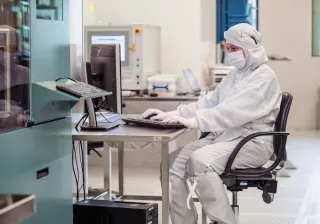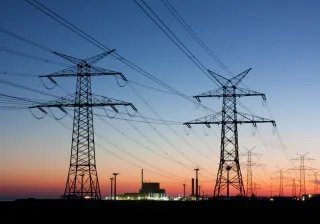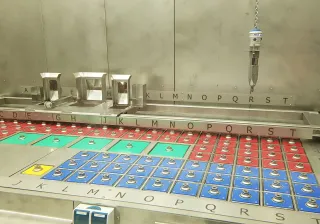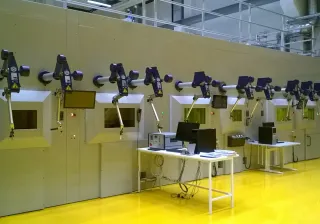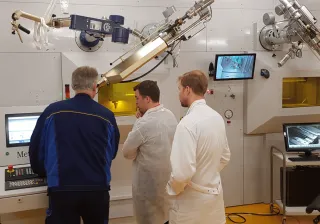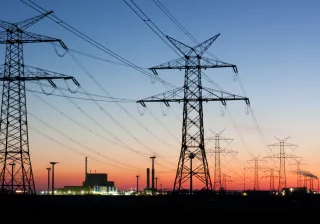VTT Centre for Nuclear Safety
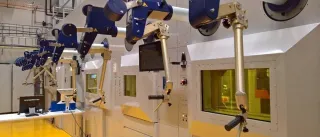
The VTT Centre for Nuclear Safety offers a wide range of services in the field of the safety and efficiency of nuclear energy generation and radioactive waste management. Using world-class experimental facilities and comprehensive nuclear safety analysis tools, our experts support regulators and industrial customers, both in Finland and internationally.
Key facts about VTT Centre for Nuclear Safety
The expertise and infrastructure at the VTT Centre for Nuclear Safety ensure the safety and efficiency of nuclear energy generation and waste management.
We support all lifecycle phases of a nuclear facility: new-build projects, operation, maintenance and plant life extension, as well as decommissioning and waste management.
We also work with clients from other industries on material characterisation and testing, elemental analyses and other projects.
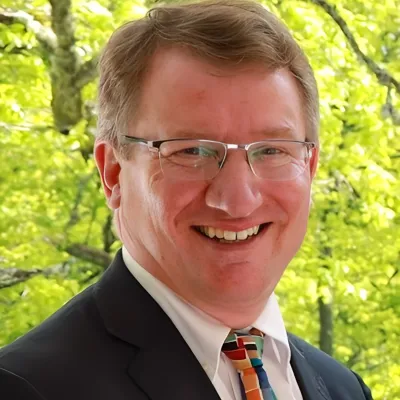
The VTT Centre for Nuclear Safety (CNS) in Espoo hosts cutting-edge multi-disciplinary laboratories and research facilities for nuclear safety analysis, all under one roof.
The centre offers a unique set of sophisticated experimental facilities, analysis and modelling software. The professional staff has multi-technological backgrounds and state-of-the-art knowledge from research projects and collaboration with the industry.
For the current list of accredited tests, see the website of the Finnish Accreditation Service FINAS. In addition to standard tests, we carry out demanding non-standard studies.

Hot cell laboratory for irradiated specimen testing
VTT’s hot cells are primarily designed for material investigations and failure analysis. Additionally, they can be used for other studies that require a radiation-shielded facility. The hot cells have thick lead brick walls and lead glass windows. The samples inside are accessed using mechanical manipulators.
Using the hot cells, we offer the following:
- Instrumented tensile, compression, hardness, fracture toughness, fatigue and impact testing and analysis
- Mechanical testing of Reactor Pressure Vessel (RPV) surveillance specimens and other RPV materials, including reconstitution and retesting of specimens
- Assessing radiation-induced damages and/or changes in properties
- Investigations of mechanisms behind radiation embrittlement
- Fuel cladding creep assessment
- Customised investigations on active materials
The lightly shielded protective cells are used for light-optical microscopy examinations as well as for preparing cross-sections and resizing specimens for microscopy.
The heavily shielded protective cell at the receiving bay is used for opening the transport cask and capsules. The receiving bay has horizontal and vertical ports for transport casks of different sizes and orientations, weighing up to 10 metric tons. The main hall has two lines of heavily shielded cells: the specimen preparation line and the mechanical testing line.
Microscopy
VTT Centre for Nuclear Safety complements VTT’s microscopy capabilities by an analytical Scanning Electron Microscope (SEM) with Focused Ion Beam (FIB), and an analytical Transmission Electron Microscope (TEM). Using them we can offer the following for non-irradiated and irradiated samples:
- Determination of crack initiation site and fracture mode, crack growth, microstructure, secondary phases, crack path in the microstructure
- Determination of microstructural metrics: grain size and texture, second phase population distributions, compositional mapping
- High-resolution compositional mapping intra- and inter-grain features
- Investigations of microstructural features at nano-scale
- Determination of radiation-induced defects in materials
- Microscopy specimen preparation, from light microscopy cross-sections to FIB lift-outs for TEM, from metals to ceramics, concrete and polymers
Fatigue testing in realistic conditions
Fatigue of structural material is a challenge for nuclear power plant’s design and operation. VTT’s solutions reduce uncertainties in plant lifetime management through the assessment of fatigue in simulated reactor conditions.
VTT’s FaBello facility operates using direct strain control. This provides results directly comparable with the design curves, which are determined using similar tests in air. This enables us to report environmental effects valid for design purposes. The FaBello facility is ASTM E606 standard and ASME III design code compliant.
Using the facility we can offer:
- Assessment of material performance in nuclear power plant components
- Material characterisation to support plant design and operation
- Component lifetime assessment based on experiments and analyses
- Codified stress analysis and design data in realistic conditions
Aerosol laboratory
Environmental safety requires gaseous-species identification and concentration measurements, particle number analysis, mass concentration and size distribution as well as particle property analysis, for e.g. chemical compounds.
We can offer gaseous-species and aerosol-particle measurements and characterisation, such as:
- Emission measurements and instrument testing for conventional power plants
- Analysis of fission products’ transport and chemistry, in both primary circuit and containment conditions in accident scenarios
- Assessment of filtration devices’ ability to mitigate releases to the environment
- Customer-tailored measurements, with sample analysis both on- and off-line
We have a comprehensive set of equipment for the characterisation of aerosols in both gas and liquid phases as well as for the characterisation of gaseous species.
Radiochemistry laboratory
In our radiochemistry laboratory, we can help you accurately characterise radioactive materials like decommissioning waste. We offer:
- Qualitative and quantitative analysis of radionuclides in structural materials, water, food, and other irradiated, contaminated, and natural materials
- Characterisation of activated and contaminated wastes, such as for decommissioning waste streams (but excluding spent nuclear fuel material)
- Surface decontamination testing
- Irradiation of components and materials
- Sample preparation, including activity detection, mechanical size-reduction, pre-treatment e.g. dissolution, incineration, chemical separation of nuclides etc.
- Tracer experiments, to evaluate transport mechanisms, surface reactions, release rates
The facilities include Liquid Scintillation Counters for alpha, beta and X-ray emitting nuclides, gamma spectrometers and alpha spectrometers.
Elemental and isotopic analyses
Do you have challenging samples which are difficult to dissolve or that have concentrations below the detection limit of your current analytical technique? We specialise in difficult sample matrices and tailor-made solutions, and our limit of detection can be as low as ng/l.
In addition to the tailor-made solutions, we offer:
- Quantitative multielemental analyses (reference the periodic table below)
- Qualitative and semi-quantitative analysis of unknown samples
- Isotopic analyses (e.g. 6Li/7Li, 10B/11B, 229Th/232Th, 235U/238U)
- Sample preparation in a clean-room when needed
- Radiochemical analyses
- Gamma spectrometric analyses
Common sample types:
- Liquids: impurities in clean water and different aqueous samples
- Solids: metals and metal alloys, sediments, minerals, biological samples and filters
Our key tools are high-resolution Inductively Coupled Plasma Sector Field Mass Spectrometer (ICP-SF-MS) and Synchronous Vertical Dual View Inductively Coupled Plasma Optical Emission Spectrometer (SVDV ICP-OES).
Impact facility for studying external impacts on structures
The structural integrity of nuclear power plant components and structures is of paramount importance in ensuring safe process shutdown in external hazard events. The purpose of the impact testing facility is to experimentally investigate the possible outcomes of airplane crash scenarios. At the same it improves the industry’s understanding on external impacts on civil structures.
Experimental impact studies are conducted on scaled specimens that represent structurally relevant parts of a nuclear facility. Various specimen shapes can be tested including simply-supported slabs and free-form complex structures. The two test frames currently in use can house concrete slabs of 2 by 2 meters and 3.5 by 3.5 meters. The different types of impacts that can be studied include so-called soft impacts akin to that of an aircraft fuselage, hard impacts akin to those of the hard parts of an aircraft like motors and impacts with liquid filled projectiles emulating the impact of the fuel tanks. In addition, propagation of the impact induced vibrations can be studied using free-form targets.
The VTT impact test apparatus can be considered as the world’s largest airgun. The apparatus uses pressurised air to accelerate the projectile to its target velocity. The apparatus operates in different scales with projectile dimensions varying from ~150 mm to ~400 mm in diameter and masses up to 300 kg with the impact velocity of the larger projectiles reaching roughly 140 m/s.

Clay laboratory
Safe permanent geological disposal of radioactive waste requires accurate characterisation of bentonite clay performance. In our clay laboratory, we can assess material performance for the structural design of geotechnical barriers. We offer:
- Microstructure measurements of clay matrices
- Chemical analyses of clay matrix
- Online measurements of pH and Eh from clay materials
- Analyses of pore water chemistry and phenomena related to diffusion, pH buffering, alteration, cation exchange, dissolution/ precipitation
- Coupled thermal, hydro-, mechanical and chemical (THMC) measurements of clay barriers, including erosion potential and transport properties
- Designing, building, maintaining, dismantling and analysis of customised experiments
Our environments with simulated conditions include:
- Controlled atmosphere boxes with oxic or anoxic conditions (gloveboxes)
- THMC devices including heater, cooler and data acquisition systems, hydration systems, sensors
- Diffusion cells, squeezing cells, hydraulic presses
Our analysis facilities include:
- Small-angle X-ray scattering (SAXS)
- Nuclear magnetic resonance spectroscopy (NMR)
- Spectrophotometer
- Inductively coupled plasma spectrometry (HR-ICP-MS, ICP-OES)
- Chemistry and radiochemistry laboratories
Our modelling tools include:
- COMSOL Multiphysics
- Hydrogeochemical modelling tools EQ3/6, PHREEQC
- Geochemist workbench, PetraSim
- Molecular modelling LAMMPS
Computational safety analyses
Computational analysis is necessary in all phases of nuclear power plant installation. Modelling and simulation can be used to rapidly assess operational and structural performance. VTT has a comprehensive set of computational analysis capabilities from neutronics and microstructures to the power plant system level.
We offer:
- Software tools
- Engineering simulators, operator training simulators
- Safety analyses for licensing support to plant vendors and licensees
- Independent safety analyses as Technical Support Organization (TSO) to regulatory safety authorities
- Training and competence development
Our analysis topics and methods include:
- Fuel and reactor core neutronics
- Radiation shielding
- Computational Fluid Dynamics (CFD)
- Transients and design basis accidents, including neutronics, thermal hydraulics, instrumentation and control and electrical systems
- Severe accidents
- Release and dose assessment
- Performance of mechanical components
- Structural behaviour, Finite Element Method (FEM)
- Fire spread and evacuation
- Probabilistic Risk Assessment: levels 1, 2 and 3
We have developed several software tools, three of which can be made available for users outside VTT:
- Apros for design basis accident analysis at plant scale, as well as for engineering, testing and training simulators. A product owned by VTT and Fortum
- Serpent for reactor physics
- FinPSA for Probabilistic Risk Assessment
Iodine laboratory
VTT has the capabilities to perform laboratory and field efficiency tests of iodine filters (activated carbon) of nuclear power plants. The tests are carried out according to the standards KTA3601 and ASTM D3803-91, and accreditations are in the process. For the laboratory tests, activated carbon samples of iodine filters are taken from the plant and transported to VTT Centre for Nuclear Safety. The tests are based on the measurement of the separation degree in these samples.
In the field and laboratory tests, the separation degree of iodine filters is measured using gaseous methyl iodide marked with I 131 (CH 3 I 127 + CH 3 I 131) as the test substance. The test substance is prepared in our own laboratory facilities using a NaI 131 solution from external suppliers. The finished test substances are collected in safe containers.
We’re also able to test HEPA-filters. The HEPA field tests are carried according to the ISO 16170:2016 standard using di-2-ethyl hexyl sebacate (DEHS).
We’re also willing to discuss the testing of any other filters.
See our publications
How to work with us
The VTT Centre for Nuclear Safety welcomes customers and regulators from all over the world. Our experts at nuclear safety analysis and our modern facilities offer answers to your nuclear safety-related questions.
-
Contact us
We are happy to help you find the right experts and services for you. Contact us and tell us what your needs are. -
Our infrastructure at your service
The VTT Centre for Nuclear Safety offers a unique set of sophisticated experimental facilities and professional staff with multi-technological backgrounds. Explore our nuclear infrastructure more. -
Finding the right way to work with us
Whether it’s collaborating on an international development project or commissioning an experiment tailored to your needs, together we can find the right way to answer your questions.

